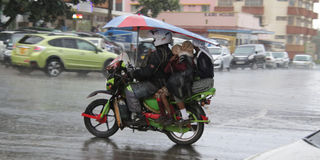Kenya weather forecast: Diverse rainfall patterns expected as El Niño conditions persist

Heavy downpour along Nyeri-Nanyuki highway at Chaka in Nyeri county on March 2, 2023.
What you need to know:
- Nairobi County, Nyandarua, Nyeri, Kirinyaga, Murang'a, Kiambu, Laikipia East, Meru, Embu and Tharaka Nithi are expected to receive rainfall throughout the season.
As the country prepares to welcome the last quarter of the year, it is bracing for a variety of weather patterns. The Kenya Meteorological Department (KMD) has released its latest weather forecast, which predicts a complex interplay of rainfall in different regions.
This pronounced wetness is attributed to the presence of El Niño conditions, driven by warmer than average sea surface temperatures (SSTs) over the central and eastern equatorial Pacific Ocean. The forecast also underscores the continuation of these El Niño conditions throughout the OND (October-November-December), as confirmed by an ensemble of global climate models.
Releasing the weather forecast for the October, November and December 2023 season, KMD Director David Gikungu highlighted that the forecast points to more rain, with some areas receiving it more heavily and others more evenly, both in terms of time and space.
"The upcoming weather is predicted to bring higher than normal rainfall to most parts of the country. This rain will be distributed fairly in some areas and more evenly in others, both in terms of timing and location," said Dr Gikungu.
However, the forecast highlights a clear meteorological outlook for regions including Siaya, Kisumu, Homa Bay, Migori, Kisii, Nyamira, Baringo, Uasin Gishu, West Pokot, Elgeyo Marakwet, Nandi, Kericho, Bungoma, Kakamega, Busia, Trans Nzoia, West Pokot, Vihiga, Laikipia (Laikipia West), Nakuru and Narok counties. These areas are on track to receive consistent rainfall throughout the season. The expected rainfall in these regions is expected to exceed the usual seasonal averages, a phenomenon known as "enhanced rainfall", according to experts.
"November will be the main event, with the heaviest rainfall. While October could see some unpredictable patterns, November and December should balance things out and spread the rain more evenly across these counties," said Dr Gikungu.
Nairobi County, Nyandarua, Nyeri, Kirinyaga, Murang'a, Kiambu, Laikipia East, Meru, Embu and Tharaka Nithi are expected to receive rainfall throughout the season. Rainfall amounts are predicted to exceed the usual long-term averages for the season.
In addition, the distribution of rainfall is expected to be even in both time and place.
"Counties such as Mombasa, Tana River, Kilifi, Lamu and Kwale are expected to receive rainfall throughout the season. Expected rainfall is expected to be above the usual long-term averages for this time of year and is expected to be evenly distributed both in terms of time and geographical area," reads the forecast.
According to Dr Gikungu, the projected start and end dates of the rains, as well as their distribution, were determined by analysing data from 7 Global Circulation Model (GCM) simulations.
The Ministry of Agriculture highlighted the mixed impact of the expected abundant rainfall in the western and eastern regions. While the rainfall is expected to bring several positive outcomes, there are also concerns about potential negative impacts on agriculture and communities.
Jane Njeri, a developer with the ministry, said with the prospect of a significant influx of rains, agricultural experts are predicting a significant increase in production. Both livestock and crop yields are expected to rise, leading to an overall increase in agricultural production in the western and eastern regions. This increase in productivity could potentially help stabilise and strengthen the local economy.
"The abundance of agricultural produce resulting from increased rainfall is also likely to lead to lower commodity prices. Consumers can expect more affordable access to staple foods, providing a cost-effective way to meet nutritional needs. Surplus production is expected to contribute to improved food accessibility, a critical factor in ensuring sustainable nutrition for communities.
"As agricultural products become more readily available, the risk of food shortages is reduced," she said.
Also read: Why Kenyans must be ready for El Nino
However, the ministry is also warning of the potential spread of pests and diseases as a result of prolonged wet spells. Both crops and livestock could be at risk, requiring vigilant pest and disease management strategies to mitigate potential losses.
Carey Owiti of the Ministry of Water announced the identification of a number of flood hotspots in different regions of Kenya. The main focus of concern is the Western Kenya region, with particular attention being paid to sections along the Nyando River in the Nyakach and Lower Nyando regions.
Areas such as R. Nzoia, Winam Gulf and the lower Sondu River are also identified as prone to flooding. Gilgil, Narok Town and Suswa in the Rift Valley have also been highlighted as flood hotspots.
"The flood assessment extends to coastal areas, particularly Voi Town, Mwatate, Tana River Delta and Garissa.These regions are prone to flash floods due to their geographical characteristics.
In north-eastern Kenya, towns such as Lodwar and Lokichar are on alert due to the presence of numerous seasonal rivers that could lead to unexpected flash floods. Even major cities and towns such as Nairobi, Mombasa, Nakuru and Naivasha are not exempt from the risks posed by the persistent heavy rains," said Mr Owiti.





